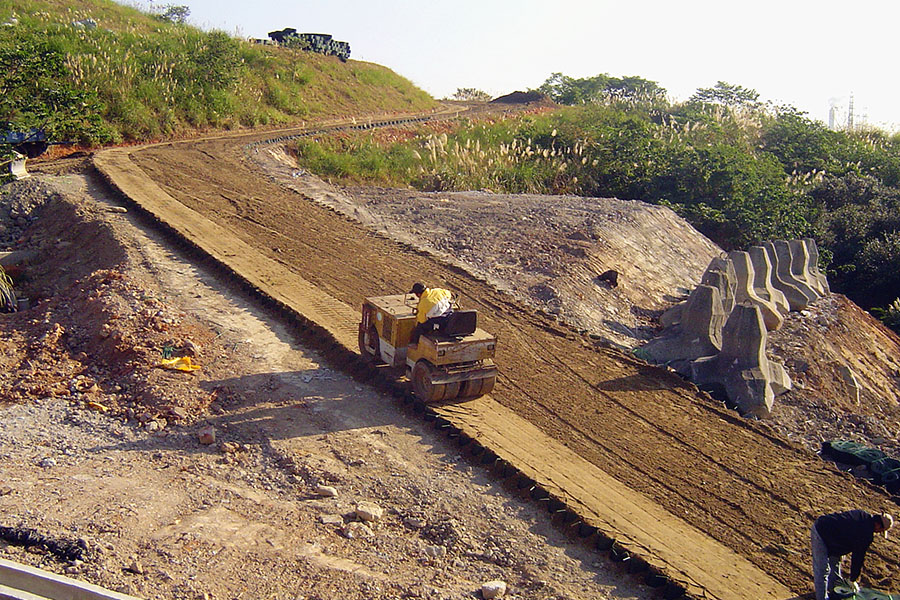What Is a Geocell?
A geocell is a three-dimensional, cellular confinement system that protects against soil erosion and stabilizes sloped surfaces. Its honeycomb shape provides a stable and flexible foundation for many infrastructure projects like road construction and retaining walls.
The geocell’s center can be filled with natural materials like soil, sediment, or gravel so it can conform to the landscape. These products are made from non-toxic materials and are environmentally safe. Geocells are an innovative solution to many production challenges in infrastructure development.
How Do Geocells Work?
Think of geocells as building blocks that can be stacked together to create a durable structure. Geocells are installed on top of soil and then filled with natural materials like dirt or gravel. The honeycomb design functions keeps the dirt in place and conforms to the ground so the sediment does not shift.
The geocell’s filler becomes compacted, which provides stability and strength against resistance like traffic, wind, and water. In road construction, geocells can reinforce sloped surfaces to prevent landslides and provide better load support.
Geocells can be perforated or textured. Perforated geocells feature small holes in the plastic that allow water to drain and air to flow. Textured geocells are made with a rough surface that grips the soil and guards against slippage.
Because of their unique design, geocells save material and manpower on roadway construction projects. Geocells are even great for flat roadways because they protect the soil from weather erosion. Because they’re also easy to install, they can usually save you time and money.
The Environmental Benefits of Geocells
The Protection and Stabilization of Steep Slope Surfaces
The geocell’s honeycomb shape keeps soil in place, which is especially important for areas with a history of landslides. Geocell grid also creates a water-resistant foundation. When rainwater falls on sloped surfaces at a high force, it can damage the soil. Geocells help absorb the rainwater, slow the flow, and safeguard against erosion.
Groundwater Recharging
Geocells also support infiltration and groundwater recharge. Their open design promotes good air and water flow, which are important for maintaining healthy water sources and ecosystems.
The geocell’s design allows water to permeate the soil’s surface and promote proper groundwater recharge. The honeycomb grid helps distribute the weight of pavement, gravel, soil, and sand. It also allows air to flow more freely through the earth.
Dust Control
Unpaved roads can release significant dust levels into the air, but geocells provide a barrier above the ground’s surface. Because geocells are designed to keep dirt in place, not as much dust is released into the air.
Geocells can be filled with gravel, soil, or sand, to create a solid surface. This can greatly improve air quality, minimize costs, and provide safe conditions for workers and residents.
Less Excavation Depth
With geocells, you may not need to excavate deep into the earth when constructing a new roadway. Because they provide additional support for the soil, geocells reduce the need for deep digging on a work site. This helps project managers save money and reduces the project’s environmental impact.
Non-toxic Foundation
Geocells are made from recycled materials or non-toxic plastic. This reduces waste and prevents harmful chemicals from being released into the environment.
Because geocells stabilize soil, there isn’t much need for traditional construction methods that can harm the ecosystem the way stone or concrete foundations do. Geocells also prevent erosion and reduce the risk of soil contamination.
More Sustainable, Lower Cost, Longer Permanent Lifespan
Geocells have become popular for providing effective roadway foundations that are sustainable, affordable, and durable.
More sustainable. One of the greatest benefits of geocells is their eco-friendliness. Geocells are designed to work with nature instead of against it. By minimizing waste, absorbing rainwater, reducing erosion, and stabilizing soil, geocells can exist peacefully within the ecosystem.
Lower cost. Geocells are filled with local materials that are easy to access, so you may not need to export pricey materials. You also don’t need heavy construction equipment to install them, which saves money on material and labor.
Longer lifespan. Another benefit geocells offer is their longevity. They have a much longer lifespan than concrete foundations. Because they are strong and durable, geocells can withstand heavy loads and still keep their shape.
This makes them ideal for areas with lots of traffic. Their design also allows for better water drainage and soil stability that prevents long-term damage and prolongs the foundation’s life.
In summary, geocells are essential for strong roadway foundations. They minimize environmental damage, reduce waste, and eliminate the need for heavy-duty construction equipment.
Geocells protect communities, roads, and the environment. These features make them ideal for affordable and sustainable roadway construction.
